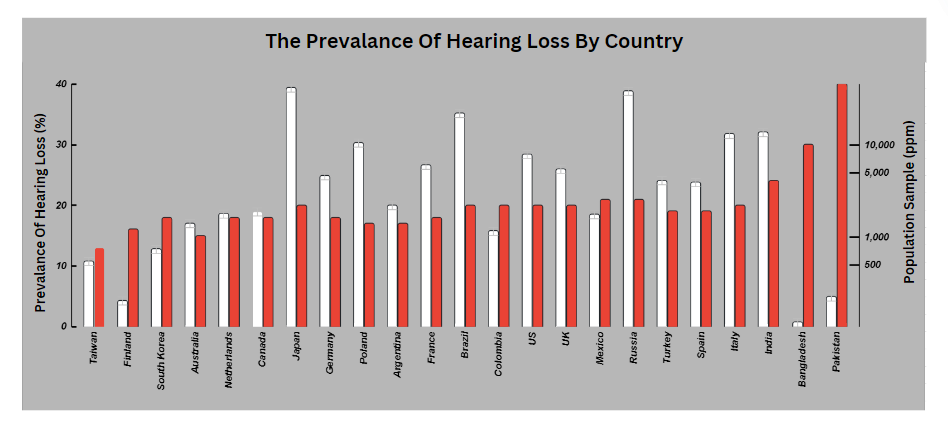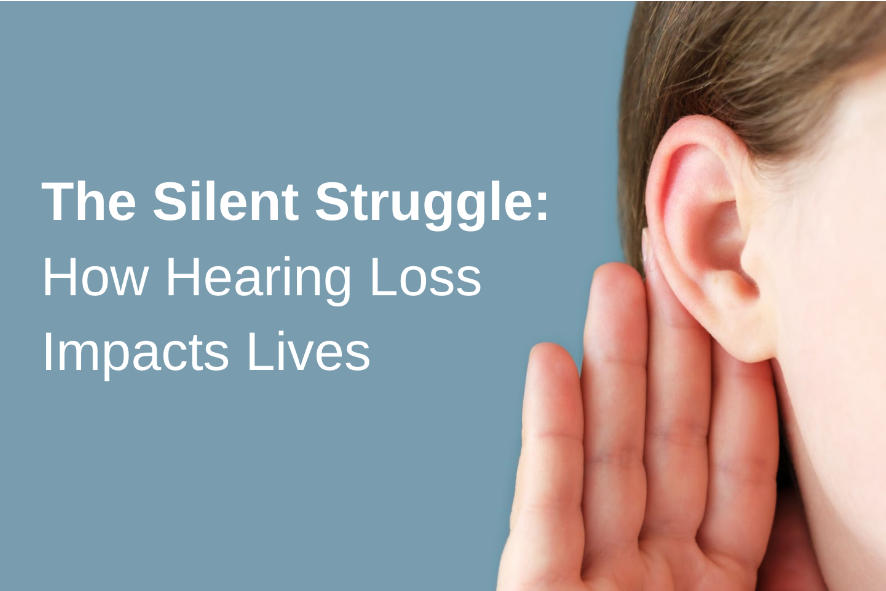Imagine navigating a world where conversations become muffled whispers, the sounds of laughter fade, and the richness of daily interactions diminishes. For millions worldwide, this isn’t just a hypothetical scenario – it’s the reality of living with hearing loss.
According to the World Health Organization (WHO), over 466 million people globally have disabling hearing loss, with the number projected to rise to 900 million by 2050. This silent struggle transcends age and background, impacting individuals across all walks of life.
The consequences of untreated hearing loss extend far beyond the inability to hear clearly. Research has shown a strong correlation between hearing loss and:
- • Social Isolation: A 2020 study published in the Journal of the American Geriatrics Society found that hearing loss can lead to social withdrawal and loneliness, significantly impacting mental well-being.
- •Communication Barriers: Difficulty understanding conversations takes a toll on personal and professional relationships. A 2019 study in the International Journal of Audiology revealed a strong link between hearing loss and decreased job performance.
- •Mental Health Concerns: Untreated hearing loss has been linked to an increased risk of depression and anxiety. A 2017 study in JAMA Internal Medicine found a significant association between hearing impairment and symptoms of depression.
- •Dementia Link: Studies suggest a connection between hearing loss and an increased risk of dementia. Research from Johns Hopkins Medicine indicates that the strain of processing sound with hearing loss may contribute to cognitive decline.
These impacts are not just individual burdens; they represent a broader societal concern. Hearing loss can limit an individual’s ability to participate fully in life, affecting their earning potential, social connections, and overall well-being.
Hearing loss affects a staggering 1.5 billion people worldwide, with 430 million experiencing disabling levels, predominantly in low- and middle-income countries, highlighting significant disparities in access to diagnosis, treatment, and hearing aids.
A Global Challenge: Hearing Loss on the Rise

Hearing loss is a surprisingly widespread issue, affecting a staggering 1.5 billion people worldwide, roughly 20% of the global population. This translates to one in five people experiencing some degree of difficulty hearing.
Even more concerning is the prevalence of disabling hearing loss, defined as a hearing loss exceeding 35 decibels in the better ear. This impacts a significant 430 million individuals globally. Worryingly, 80% of those with disabling hearing loss reside in low- and middle-income countries. This highlights a significant disparity in access to proper diagnosis, treatment, and hearing aids.
Age is a significant factor, with hearing loss becoming increasingly common as we get older. Over 25% of people above 60 experience hearing loss, impacting their ability to fully engage with the world around them.
The future projections paint a concerning picture. By 2050, the WHO estimates that a staggering 2.5 billion people will have some form of hearing loss, and a substantial 700 million will require access to audiological services. These numbers underscore the urgent need for innovative solutions and increased accessibility to address this growing global challenge.
India’s Outlook
The Indian ENT (Ear, Nose, and Throat) market presents a unique set of challenges and opportunities. With a diverse population, varying healthcare infrastructure, and a rapidly aging demographic, the demand for audiology devices, particularly hearing aids, is on the rise. The United Nations Population Fund predicts that India’s elderly population will double by 2050, reaching 347 million, surpassing the number of children. The stark reality is that about one-third of older adults have hearing loss, and with age, this number climbs even higher. This translates to millions more people potentially facing hearing challenges.
Access to hearing healthcare services remains a significant challenge, especially in rural areas with limited infrastructure. The Indian healthcare regulators, including the Central Drugs Standard Control Organization (CDSCO) and the National Health Authority (NHA), have issued new risk-based classification lists and regulations for ENT and medical devices, requiring all ENT products to be registered to comply with the latest Medical Device Rules in India. This regulatory framework aims to ensure the safety and efficacy of ENT devices while fostering growth and innovation in the sector.
Despite these hurdles, the market offers immense potential. Rising awareness, increasing disposable income, and a growing elderly population create a perfect storm for market expansion.
Globally, less than 10% of hearing aid needs are met annually, with a significant shortage in developing countries despite 80% of deafness cases being preventable or manageable. In India, where over 63 million people have significant auditory impairment, high costs, limited accessibility, and sparse healthcare resources in rural areas amplify socioeconomic challenges for the hearing impaired.
Hearing Aid Market
Current annual production of hearing aids is thought to be less than 10% of global needs and less than one out of every forty hearing aids needed in developing countries actually goes there. The burden of deafness is mostly preventable and avoidable. According to the WHO, half of deafness cases can be prevented, and 30%, while not preventable, can be managed with assistive devices. Therefore, around 80% of all deafness cases are avoidable.
In India specifically, more than 63 million people suffer from “Significant Auditory Impairment.” Hearing aids and frequent doctor’s checkups are far too expensive for most, which leads to people ignoring their issues, making their hearing even worse in the long run. But the larger issue that plagues India is the lack of testing. It is exceedingly difficult for people to test their hearing and find a suitable device to aid their hearing. Even if one knows about their impairment and has the means to treat it, there is a severe lack of help. Currently, the ratio between audiologists and the Indian population is 1:150,000, while the ratio between speech therapists and the deaf population is 1:2000. India also has a huge economic impact due to lost productivity, higher unemployment, and lower wages for the hearing impaired. This issue is exasperated by the fact that the vast majority of any type of treatment is available in urban areas of India, while rural areas are still vastly unserved. This problem is continuing to grow while people anxiously await a viable solution to their problems.
z21 Ventures has invested in earKART for its innovative approach to revolutionizing audiological care in India, enhancing clinic efficiency and accessibility through advanced technology, including a pioneering remote diagnosis system.
Investment Announcement
We at z21 Ventures are proud to invest in companies that revolutionize industries while creating positive social impact.
We recognized earKART’s potential to disrupt the audiological market and bring the necessary treatment to millions of people in India by making the Hearing test hyper localised. EarKART’s ability to use their Remote Video Audiometry devices to provide reliable, scientific and quicker results for patients cuts down on time spent traveling long distances, and results in audiologists being able to see more patients per day. Their testing device is also more cost-effective for clinics and doesn’t require a dedicated audiologist to physically run it, as the device can be remotely run by an Audiologist. Each audiologist can effectively manage 6-8 remotely managed devices. There are over 1350 clinics that use their clinics around India, further expanding their reach and impact across India.
Because of the increased accessibility of the clinics, it becomes easier for patients to book appointments to test their hearing and figure out which aid best matches their needs. Their innovative, affordable, and durable hearing technology is improving access to hearing aids for patients around India. Along with the vast array of clinics and technology, patients can schedule at-home setups, where experienced audiologists will assist in fitting and adjusting a patient’s hearing aids.
In addition to their existing technology, earKART has applied for a patent that merges medical device diagnostics with remote computing, setting the stage for the world’s first remote diagnosis and remote programming audiology model.
EarKART’s success is driven by an extremely experienced team, with rich industry-specific experience. Rohit Misra, their CEO and co-founder, has extensive years of experience in the audiological space. If you’d like to connect with Rohit Misra, CEO and co-founder of earKART, you can find him on LinkedIn.
As the number of people who require additional support for their hearing increases, earKART looks to help as many people as possible. EarKART looks to capture and grow the market while bringing its audiological services to more people who currently don’t get the care that they so desperately require.
To learn more about earKART’s mission and how their technology is changing lives, visit their website.
